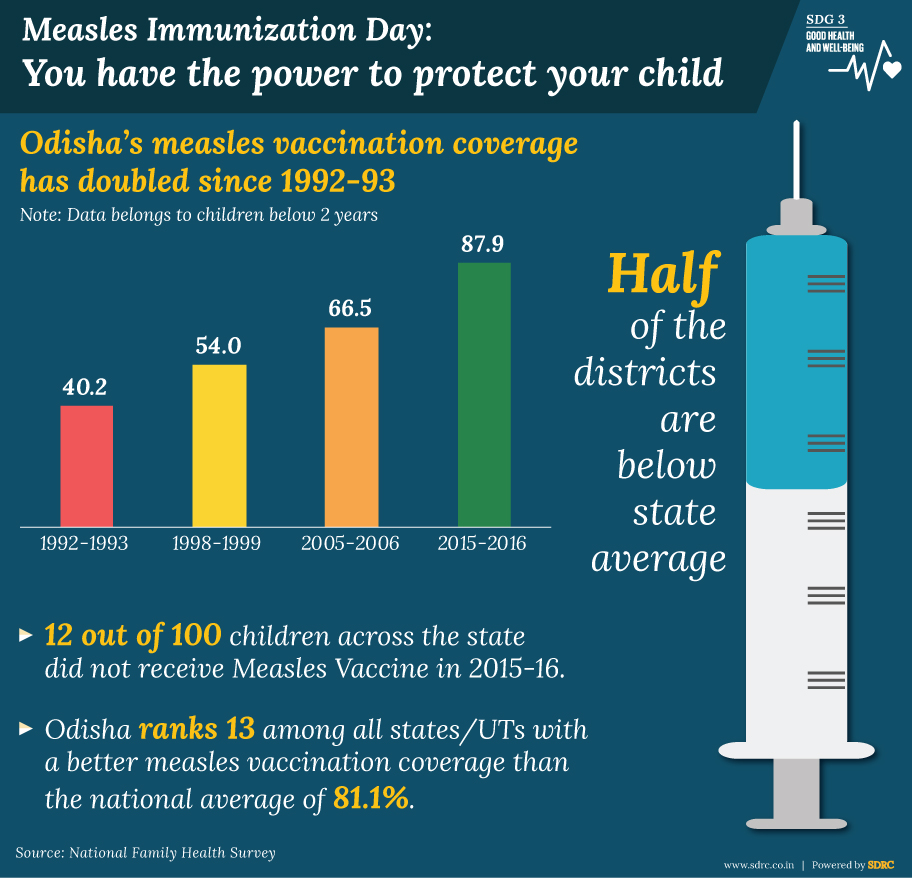Bablu, a seven-year-old boy from Khiligunda village in Gajapati district, developed high fever, red blotchy rash on skin, inflamed eyes and incessant cough. He was taken to the nearest community health centre and was diagnosed with severe measles. After a high dose of vitamin A and intravenous antibiotics, he was referred to the district headquarter hospital. But by the time he reached there, it was too late. It was later discovered that he wasn’t vaccinated for measles.
Measles Immunization Day
Every year on March 16, Measles Immunization Day is observed to create awareness among people about the highly contagious and deadly disease.
Measles is caused by a virus that reproduces in the throat and nose of an infected adult or child. When they sneeze, cough or talk, other people are likely to inhale the contaminated droplets in the air.
Although there is no treatment for the disease, there is a safe and cost-effective vaccine to protect healthy people from contracting the disease.
Before measles vaccine was introduced in 1963, serious epidemics occurred nearly every two-three years and the disease resulted in approximately 2.6 million deaths every year around the globe. About 2.7 million children in India are infected with measles every year.
Interesting facts about Measles Vaccination
According to the World Health Organization, here are some key facts about measles vaccination:
- Between 2000 and 2018, measles vaccination accounted for a 73% decline in measles deaths all over the world. In the same time period, the vaccination prevented about 23.2 million measles deaths.
- In 2018, nearly 86% of children all over the globe were given single dose of measles vaccine through routine health services by their first birthday – an increase from 72% in 2000.
- In use for more than 40 years, the vaccine is safe and an effective and is given in several countries all over the globe.
- Two doses of the vaccine should be given to children below two years. However, it can be given till five years of age if a child missed the scheduled dose.
Where does Odisha stands in terms of measles vaccination coverage?
As per the National Family Health Survey, the state of measles vaccination coverage in Odisha are as below:
- Measles vaccination coverage in the state has more than doubled since 1992-93 from 40.2% to 87.9% in 2015-16.
- The state ranks 13th among all states and union territories with a better vaccination coverage compared to the national average of 81.1%.
- However, it is a matter of concern that over 12 out of 100 children in the state did not receive measles vaccinations in 2015-16.
- 15 districts – Nuapada, Baleshwar, Bargarh, Sambalpur, Nabarangapur, Debagarh, Malkangiri, Kandhamal, Kendujhar, Kendrapara, Khordha, Rayagada, Koraput, Ganjam, and Gajapati – are below the state vaccination coverage.
Who are at major risk?
- Unimmunized children are at the highest risk of the disease and its problems.
- Unvaccinated expectant mothers are at major risk of contracting the disease and giving birth to an infected baby.
- People suffering from autoimmune disorders are also at risk. People with compromised immunity (they have been vaccinated or were vaccinated but didn’t develop immunity) are also likely to contract the disease.
What can be done to prevent the disease?
The World Health Organization recommends immunization for all children with two doses of measles, either alone or measles-mumps-rubella (MMR) or measles-rubella (MR) combination.
What the government is doing to ensure maximum vaccination coverage?
In 2017, the Indian Government rolled out pan-India measles-rubella vaccination campaign to prevent diseases.
The vaccination is provided under Universal Immunisation Programme at 9-12 months of age and the second dose at 16-24 months of age.
Download the snapshot here.




